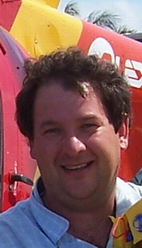Program Information
Performance of Cross-Modality DIR Algorithms Using Images Computed From a Novel, Tissue-Like Phantom Capable of Reproducible Degrees of Deformation
D Ionascu*, E Castillo , A Qin , D Solis , D Lack , R Sandhu , S Yee , T Guerrero , Beamont Health System, Royal Oak, Michigan
Presentations
TU-AB-202-9 (Tuesday, August 2, 2016) 7:30 AM - 9:30 AM Room: 202
Purpose:Develop a framework for the spatial accuracy assessment of multi-modality deformable image registration (DIR) based on precise and reproducible deformations of a novel prostate phantom.
Methods:An existing, tissue-like prostate phantom has been adapted to allow quantifiable, reproducible, and variable degrees of volumetric deformation. This phantom is sequentially deformed into 11 stationary deformation states that can be individually imaged using CT, MRI, US and CBCT. The deformation is induced programmatically by changing the water volume of a balloon using a precise syringe pusher (5ml increments), effectively displacing and deforming the prostate and surrounding tissue. To demonstrate the phantom’s utility as a DIR assessment tool, selected DIR algorithms (CT<->MR: Normalized Mutual Information, MR-MR: Mutual Information, CT-CT: Local Cross-Correlation+Mutual Information) were applied to intra and cross- imaging modalities depicting varying degrees of deformation. DIR accuracy was assessed via the DICE overlap score, calculated between the deformed prostate contour (computed by warping the manually delineated contour on the initial deformation state) and the manually delineated contour on the target deformation state.
Results:DICE coefficients show excellent agreement of individual deformation states for MR and CT, hence validating the reproducibility of the induced deformation (< 1.0 + 0.1 %). Intra-modality DIR (MR-MR, CT-CT) shows good performance (0.93-0.98). CT-to-MR performance is acceptable only for the closest 5-6 deformation states (> 0.94), while the DIR solutions for farthest 6 deformation states (0.78-0.92) are erroneous or artifactual. MR-to-CT DIR performance is demonstrably weaker (0.0-0.96) yielding asymmetrical errors w.r.t. the initial deformation state (no-deformation vs. max-deformation). Moreover, the first 3 deformed contours show zero overlap with the manual contours.
Conclusion:We have developed a novel prostate phantom capable of gradual and reproducible deformation, and demonstrated its ability to assess multi-modality (CT<->MR) DIR algorithm performance and range. Due to the phantom multi-imaging capabilities, other cross-imaging DIR algorithms can now be explored.
Contact Email:

